Did you know 92% of people who rearranged their furniture found the best layout? Furniture arrangement is key in interior design. It can turn a cramped, chaotic room into a welcoming, functional space. By learning about flow and balance, you can make spaces that fit your lifestyle and taste.

Arranging furniture for the best flow makes spaces comfortable and useful. It lets you mix different furniture styles for a unique, personal space. Knowing about flow in interior design is vital for creating beautiful, functional areas. Flow means easy movement, guiding people smoothly from one spot to another.
To get this right, you need to balance looks and function. This ensures your space is not only beautiful but also meets the needs and comfort of those who use it.
Before you start arranging furniture, take a moment to assess your space. Measure the room’s dimensions to get a sense of its size and shape. This will help you decide where to place furniture and make the most of the room.
Think about the room’s natural light, architectural features, and how people move through it. Identify key points like windows, fireplaces, or entryways. Knowing these will help you use the room wisely and create zones for different activities.
With a good understanding of your room’s layout, divide it into different zones. These can include seating areas, dining spaces, workspaces, and cozy corners. By organizing furniture into these zones, you can keep the room open and functional.
By assessing your space and creating functional zones, you’re on your way to a beautiful and practical room. Remember, the secret to good space planning is understanding your room’s unique features and tailoring the layout to fit your needs and lifestyle.
When setting up furniture, focus on the size and balance of each piece in the room. Big furniture can make a small space feel cramped. On the other hand, small pieces can get lost in a big room. Mix furniture sizes to add interest and balance.
It’s also key to keep paths clear for easy movement. Arrange furniture to guide people smoothly through the room. This makes it easy to move around, whether you’re heading somewhere or just passing by.
Proportion is crucial for furniture arrangement. It balances objects and furniture in the room. Think about textures, colors, patterns, shapes, and sizes to get a harmonious look. Don’t put big items next to small ones, as it can mess up the room’s balance.
To balance a room, spread out big and small items. You can use symmetrical or asymmetrical balance. Symmetrical balance uses similar objects on both sides. Asymmetrical balance uses different objects but similar weight for creative placement.
The size of the room affects furniture choices. Big rooms can handle large sectionals, while small spaces need compact sofas and chairs. In open-concept layouts, furniture and colors help connect different areas, making movement smooth.
For better traffic flow, use furniture that fits well with other pieces. Think about the room’s purpose and avoid overcrowding. If needed, get help from a professional designer. By focusing on scale, proportion, and clear paths, you can make a space that’s both beautiful and functional.
Living in a small space means every inch counts. Multifunctional furniture ideas are a smart choice. These pieces do more than one thing and make your space more organized. Think of storage ottomans, sofa beds, and extendable dining tables as space-saving solutions.
Remember to use vertical space utilization too. Wall-mounted shelves, bookcases, and cabinets help keep your space tidy and open. They let you show off your decor while saving floor space.
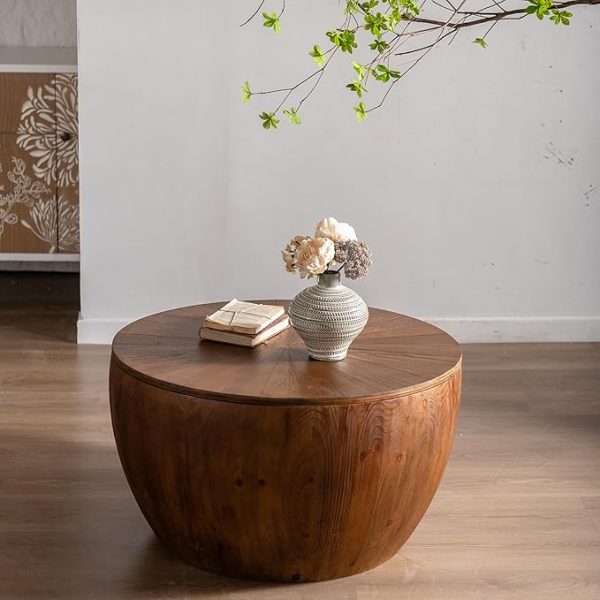
“Choose furniture that does more than one thing to make the most of your small space.”
Visit EclecticRooms.com for more ideas:
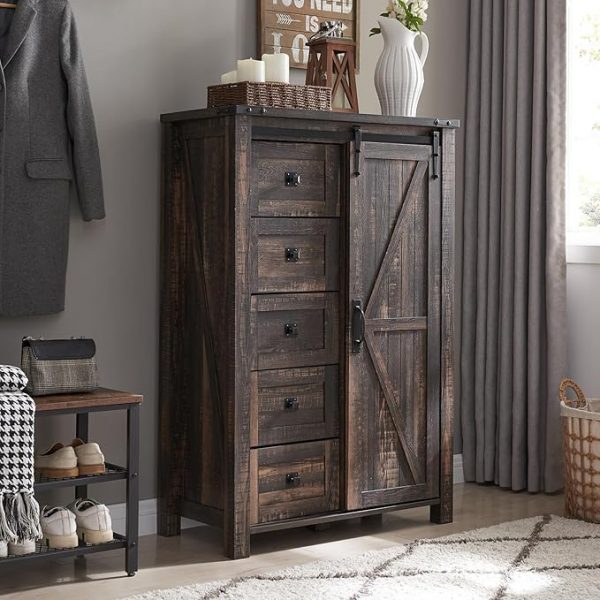
Arranging furniture can be fun and creative. It lets you turn your living space into a cozy and useful place. Don’t be shy to try different layouts until you find the best one for your room.
Begin with the big pieces like sofas and beds. They are the base of your setup. Then, add smaller items like chairs, tables, and ottomans. This adds interest and creates different areas in the room.
Remember, arranging furniture is a journey. Be ready to change things up as you see fit. Trying out different ways can help you find the best mix of optimal furniture placement, furniture arrangement tips, and interior design basics.
Getting good at furniture arrangement makes your space better and more peaceful. By being open to trying new things, you can make your home show off your style and tastes.
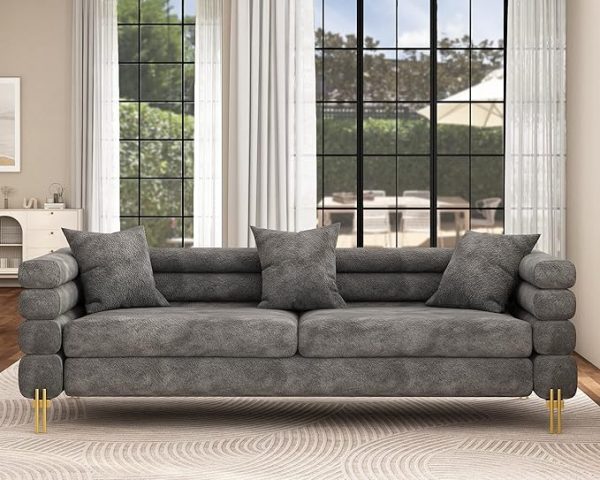
| Furniture Grouping Styles | Advantages |
|---|---|
| L-shaped | Allows for multiple functions, such as conversation and watching TV |
| U-shaped | Enables eye contact and provides for easy interaction between people |
| Box-shaped | Adds extra seating to the U-shaped furniture grouping, forming a square |
| H-shaped | Involves placing furniture facing each other, with a coffee table in the middle, around a focal point |
| Circular | Arranges furniture in a circular shape around a table, suggesting a cozy and intimate set-up |
Trying out different furniture setups can help you find the best layout for your space. It’s all about finding the right mix of optimal furniture placement, furniture arrangement tips, and interior design basics. Being creative and flexible can turn your home into a true reflection of you.
Creating a harmonious living space starts with understanding ‘flow’ in interior design. Flow means moving easily from one area to another. By arranging furniture well, you make your space both beautiful and useful.
Flow is key to a welcoming and easy-to-move-around space. It’s about where you put doors, furniture, and how people move around. Good furniture arrangement makes your space feel open and full of positive energy.
Start by measuring your space accurately. This step helps you avoid mistakes like too much furniture or bad placement. Use floor plans or digital tools to arrange furniture. This ensures everything fits well and paths are clear.
By planning and arranging furniture with flow and function in mind, you create a space that looks great and works well. This makes your home more enjoyable and healthy.
The living room is often the heart of a home. It needs careful thought in its furniture layout to be welcoming and connected. Start by finding a focal point, like a fireplace, artwork, or window. This anchor point helps place furniture for a cohesive look.
When setting up your living room, think about socializing and comfort. Choose a layout that makes talking and moving easy. Make sure there’s enough space between furniture and clear paths to make the room feel bigger and balanced.
The focal point in your living room is key. It could be a fireplace, art, or a window. Place furniture around it to create a welcoming and cohesive space.
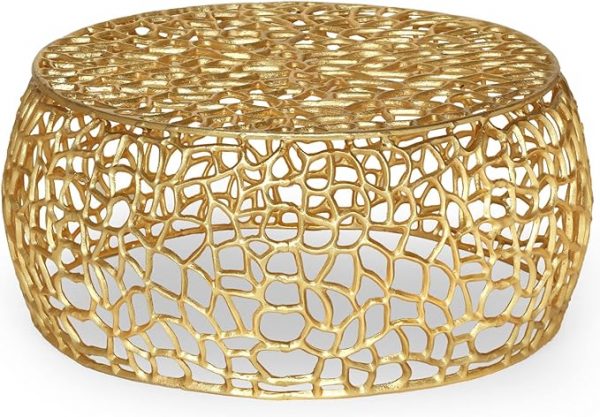
Think about how furniture placement affects socializing and comfort. Choose layouts that encourage talking, like symmetrical or L-shaped setups. Keep paths clear to make the room feel open and easy to move around.
| Furniture Layout Strategy | Key Benefits |
|---|---|
| Symmetrical Layout | Versatile and classic, suitable for any size or shape of a room |
| Floating Furniture Layout | Ideal for rooms with many windows and limited wall space, creating a central island |
| L-Shaped Layout | Presents challenges but offers opportunities for furniture and TV placement on two walls |
| Irregular or Awkwardly Shaped Rooms | Create zones with furniture and utilize statement pieces like oversized floor lamps |
| Long, Narrow Rectangular Rooms | Feature sofas placed on one wall and the TV on the opposite wall |
By focusing on the focal point and comfort, you can make a living room that looks great and works well. It’s a space where you and your guests can relax and enjoy each other’s company.
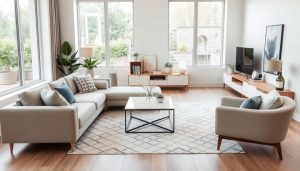
Creating a welcoming dining space is an art. The right dining table placement is key. Place it for easy access, plenty of seats, and free movement. This ensures a cozy dining experience for everyone.
Lighting is also vital for the dining room’s feel. Choose fixtures that light up and style the room. With the right furniture and lighting, your dining room becomes a place for fun and connection.
With the right furniture layout and lighting, your dining room becomes a place for connection and fun. It’s where memories are made and moments shared.
The bedroom is a personal retreat that needs a layout for relaxation and style. The bed’s placement is key, offering comfort and function. Adding storage solutions makes the space tranquil and orderly, crucial for good sleep.
The bed should be the room’s centerpiece. Place it to use space well and ensure easy access. A bed against a wall helps the room flow better.
Adding end-of-bed benches or ottomans brings extra seating and storage. This keeps the room’s look cohesive.
Good storage keeps the bedroom clutter-free and calm. Use wall shelves and cabinets to save floor space. Choose slim dressers for storage without taking up too much room.
Place accent chairs or reading nooks for personal relaxation spots. This balance of bed placement and storage makes a bedroom that’s both comfy and functional.
| Feature | Percentage of Bedroom Layouts |
|---|---|
| Bench or ottoman at the end of the bed | 79% |
| Accent chair for seating area | 45% |
| Dresser size variation for couples | 21% |
| Different dresser heights for visual interest | 33% |
| Preference for slim and tall dressers | 58% |
| End-of-bed bench for practicality and design | 67% |
| Accent chair next to dresser | 12% |
| Reading chair in the bedroom | 24% |
| Accent chair next to nightstand | 37% |
| Dresser and chair on the same wall | 19% |
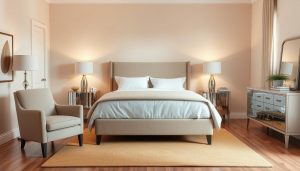
“Individuals spend a third of their life in bed, highlighting the significance of creating a comfortable and visually appealing bed space.”
Embracing Feng Shui can make your living space harmonious and balanced. At its core is the concept of Yin and Yang. These forces control energy flow in your home. By mixing textures, using colors wisely, and arranging furniture, you can create a space that flows well and feels balanced.
Soft and hard textures are key to a balanced and appealing space. Mix plush fabrics like velvet with sleek surfaces like wood or metal. This mix softens the energy and prevents a harsh feel.

Colors greatly affect a room’s energy. Use a palette that blends warm and cool tones for balance. Warm colors like reds add energy, while cool colors like blues calm. Choosing and placing colors wisely can improve your space’s Feng Shui.
Furniture arrangement is vital for energy flow. Place furniture for easy movement. Avoid furniture that blocks paths to keep energy flowing well. This creates a space that welcomes positive energy.
By applying these Feng Shui principles, you can make your space beautiful and balanced. Use feng shui furniture arrangement, balanced furniture arrangement, and flow of movement in interior design to create a refreshing and calming place.
Making your living space harmonious is like creating art. It’s not just about putting furniture in a room. It’s about mixing textures and colors in a way that feels right.
Begin by adding different textures to your furniture. Use soft fabrics, smooth surfaces, and natural materials like wood or stone. This adds depth and interest. Try mixing things in a way that feels new but still works together well.
Think about the colors you use too. Choose a color scheme that works well together. Stay away from colors that clash. Instead, pick colors that make your space feel calm and welcoming.
| Design Element | Harmony in Interior Design |
|---|---|
| Textures | Blend soft, smooth, and natural materials to create visual interest and depth. |
| Color Palette | Choose a harmonious color scheme that promotes a sense of cohesion and calm. |
| Furniture Arrangement | Organize furniture to foster conversation and interaction, creating a welcoming environment. |
| Personal Touches | Incorporate sentimental objects or artwork to infuse your living space with a sense of personality and comfort. |
By focusing on balance, color, and personal touches, you can make your space feel peaceful and true to you. This creates a place that feels like home.
“When you create a space that feels balanced, functional, and aesthetically pleasing, you cultivate an environment that nurtures the soul and inspires the mind.”
Mastering the art of placing furniture is key to making any room better. By using smart room design and feng shui, you can make your space look good and work well. This helps your daily life and makes you feel better.
Whether your room is big, small, or just right, this article has tips for you. You’ll learn how to arrange furniture for the best flow and look. You’ll also learn about creating zones and balancing your space.
The secret to a great home is in the little things. Choose the right furniture and think about how people move around. Add personal touches with accessories. This way, your home will show off your style and support your life.
Start using these tips to make your home a cozy, beautiful, and useful place. It’s all about finding the right balance and making your space your own.